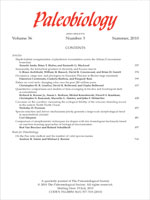New mid-Cretaceous stable isotope (δ18O and δ13C) records of multiple planktonic foraminiferal species and coexisting coccoliths from Blake Nose (western North Atlantic) document a major depth-ecology reorganization of planktonic foraminifera. Across the Albian/Cenomanian boundary, deep-dwelling Praeglobotruncana stephani and Rotalipora globotruncanoides adapted to living at a shallower depth, while, at the same time, the population of surface-dwelling Paracostellagerina libyca declined. Subsequently, the opportunistic species Hedbergella delrioensis shifted to a deep environment, and the deep-dwelling forms Rotalipora montsalvensis and Rotalipora reicheli first appeared. The primary paleoenvironmental cause of the observed changes in planktonic adaptive strategies is uncertain, yet their coincidence with an earliest Cenomanian cooling trend reported elsewhere implicates the importance of reduced upper-ocean stratification. Although there has been an implicit assumption that the species-specific depth habitats of fossil planktonic foraminifera were invariant through time, planktonic paleoecology is a potential variable. Accordingly, the possibility of evolutionary changes in planktonic foraminiferal depth ecology should be a primary consideration (along with other environmental parameters) in paleoceanographic interpretations of foraminiferal stable isotope data.
How to translate text using browser tools
1 June 2010
Depth-habitat reorganization of planktonic foraminifera across the Albian/Cenomanian boundary
Atsushi Ando,
Brian T. Huber,
Kenneth G. MacLeod
ACCESS THE FULL ARTICLE





